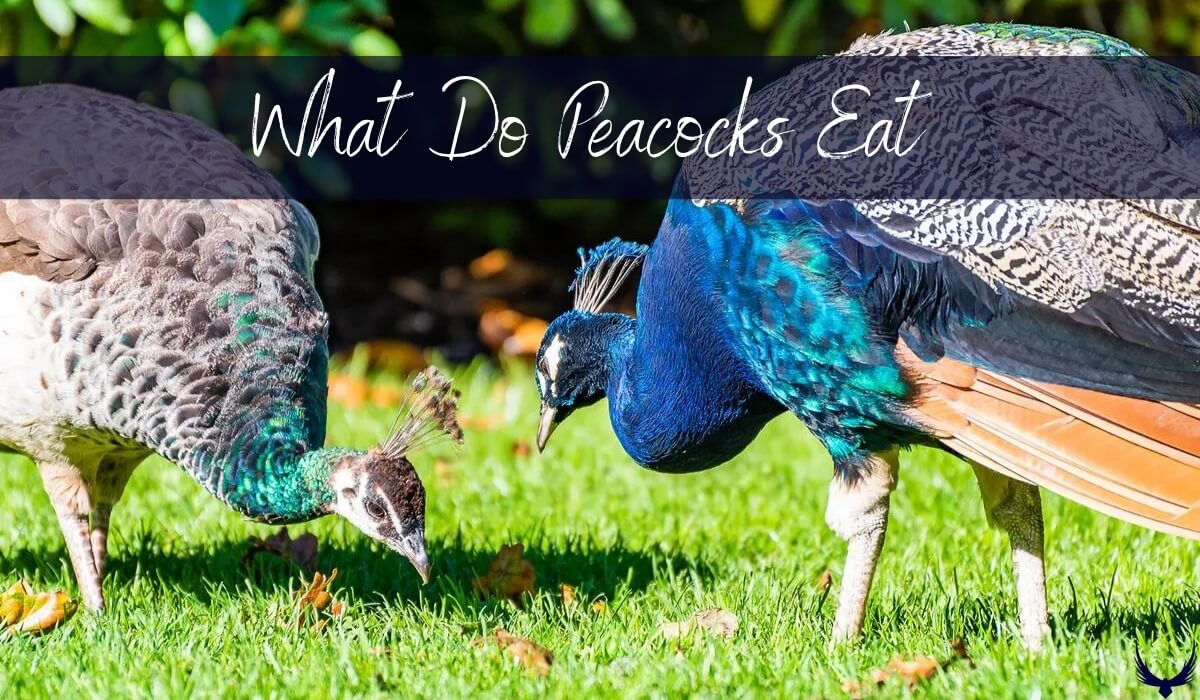Peacocks are beautiful and majestic birds, but have you ever wondered what do peacocks eat and drink? What types of food do they prefer in the wild, and what should they be fed when kept in captivity?
How much do they eat each day, and how often do they need to drink water? Do their eating habits change depending on the season or their environment?
In this article, we will explore these questions and uncover what makes up a peacock’s diet, how they forage for food, and the best way to care for them.
What Do Peacocks Eat?
Peacocks are omnivores, so they eat both meat and plants. They need a diet high in protein to keep their feathers healthy and they usually have big appetites. They are not picky eaters and will consume almost anything.
Peafowls primary source of nutrition comes from vegetation, especially when they are not breeding.
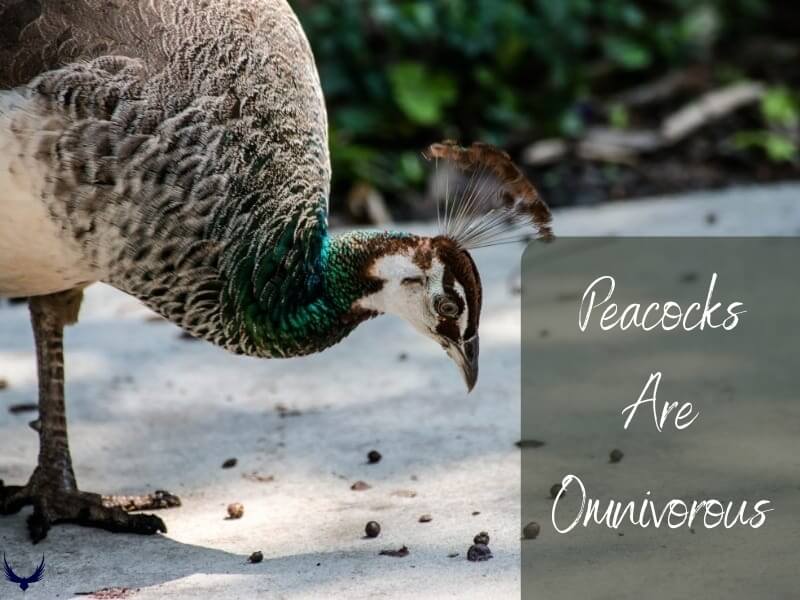
In the wild, Peacocks eat fruits, berries, grains, small animals, reptiles, and insects like ants, crickets, and scorpions. They also eat seeds, grass, plants, and flowers. They look for food in fields, meadows, and forests. They are opportunistic feeders, which means they eat whatever they find around them.
In captivity, they eat commercial poultry feed, fruits, and vegetables.
Peacock Species
Scientists have identified 3 types of peacocks. We will talk about what they eat and where they live.
- Indian Peacock
- Green Peacock
- Congo Peacock
What Do Indian Peacocks Eat?
Indian peacocks are omnivorous, so they eat worms, insects, reptiles, amphibians, and plants like roots, fruits, grains, nuts, and flowers.
The Indian peacock is found in India and Sri Lanka, but can also be seen in Pakistan, Java, Ceylon, Malaya, and Burma. They live in savannahs, grasslands, mountains, and rainforests.
What Do Green Peacocks Eat?
Green peacocks are also omnivorous. They eat insects, plants, seeds, shoots, reptiles, and worms. Green peacocks are mainly found in Cambodia, Vietnam, Myanmar, and Indonesia. They inhabit forests, savannahs, grasslands, shrublands, and on land.
What Do Congo Peacocks Eat?
The Congo peafowl are omnivorous, and they eat fruits from trees, insects, spiders, mollusks, worms, and other small creatures in its habitat.
The Congo peafowl lives only in the Central Congolian lowland forests in the Democratic Republic of the Congo. It lives in forests near slopes and watersheds.
What is Peacock Favourite Food?
Peacocks need a diverse and high-quality diet because they are big birds with specific dietary needs. They like to eat legumes and vegetables such as beans, peas, and leafy greens.
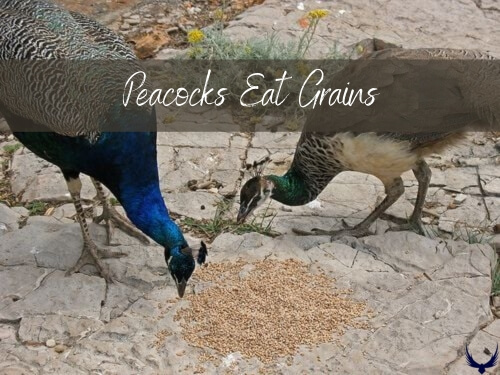
Berries and fruit give vitamins, while meat like dried mealworms and larvae provide protein. Captively breed peacocks don’t usually need rodents, amphibians, or lizards, but they will eat meat and kitchen scraps.
What Do Wild Peacocks Eat?
Peacocks use their strong beaks to hunt small animals like lizards, snakes, and rodents. They also eat bugs like centipedes, millipedes, and scorpions, as well as berries, seeds, grains, plants, and flower petals.
They eat a diet high in protein, mainly from insects. They are not afraid to hunt small snakes, rodents, bugs, and frogs for food.
What Do Baby Peacocks Eat?
Baby peacocks, also known as peachicks, are cared for by their mothers until they can find food on their own. Baby peacocks are like other baby birds in their family. They start looking for food on their own shortly after they hatch, but they stay close to their mother.
Peachicks eat by picking up food from the ground as they walk around. It takes over 2 years for them to become mature. It also takes about 3 years for peachick feathers to fully grow. They prefer softer foods while they are young and avoid eating snakes, lizards, and big insects until they are bigger. They mainly eat small seeds, insects, and berries.
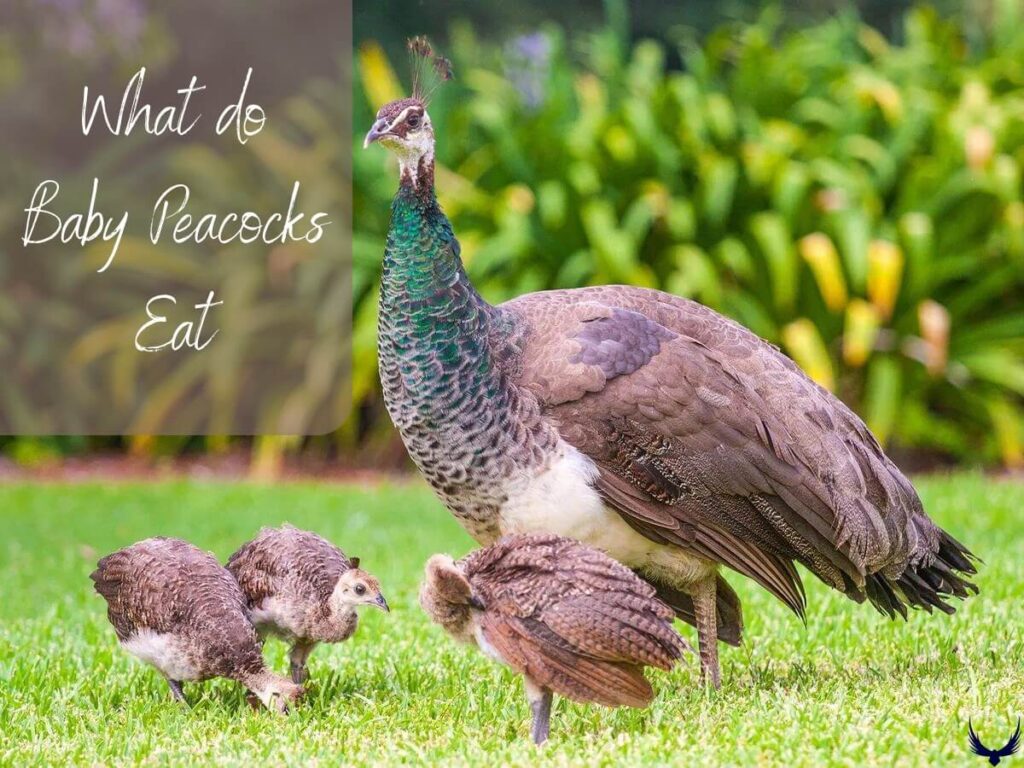
Domesticated baby peacocks are easy to raise but need proper care. They need a lot of protein in their diet for the first 3 months. In the wild, they get protein from insects, but on a farm, they may not find enough. Peacock owners usually give them commercial gamebird food to make up for the lack of protein in their diet.
How Much Should You Feed Peacocks?
Peacocks should be fed approximately 1/4 to 1/2 cup of feed per bird per day. Their diet should consist of a mix of grains, seeds, and occasionally insects or small rodents.
It’s important to provide a balanced diet and avoid overfeeding, as peacocks are prone to obesity. Supplementing their feed with fresh fruits, vegetables, and greens can also be beneficial.
When Do Peacocks Eat?
Peacocks are diurnal feeders. They are active during the day and eat in the morning and evening. They forage for their food, which includes grains, seeds, insects, and small reptiles or amphibians.
Peacocks will also eat fruits and vegetables if available. Their feeding times are determined by their natural circadian rhythms.
How Do Peacocks Hunt?
Peacocks hunt using their sharp vision and hearing. They search for fish, insects, reptiles, and amphibians. When they see their prey, they catch it with their beaks and eat it.
Peacocks usually find food on the ground, but sometimes they fly up to get a better view of an area. Their keen eyesight helps them spot prey far away. Once they see their prey, they fly down to ambush and eat it.
What Do Peacocks Drink?
Peacocks also drink water like other birds. They need their own clean water supply because they are large birds and won’t stay hydrated enough from their food.
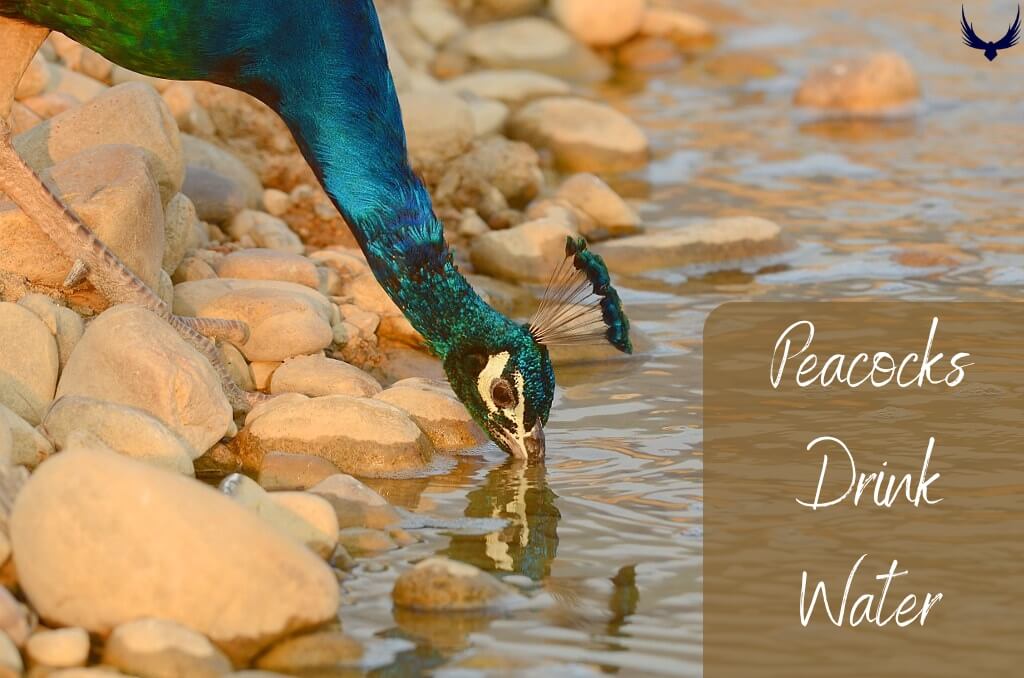
Adult peafowl needs 2 to 3 cups of water every day. In hot places, they may need more water. Make sure to always have fresh, cool water for them.
Recommended Peacock Food
Following is the Peacock food list:
Insects
Peafowl really like to eat insects. Peacocks will eat ants, flying insects, grubs, and other bugs. They also eat spiders and look for worms and small creatures by scratching the soil.
Amphibians & Reptiles
Peacocks eat lizards, frogs, snails, and slugs because they are high in protein. They also like to eat flowers, but not because they enjoy them. Peacocks tear apart flowers to find snails and insects that live on them.
Vegetables & Grain
Peacocks eat corn, wheat, and other grains. They also eat beans, peas, and may break open tomatoes, bell peppers, and fruits to get to the seeds inside. Cantaloupe and watermelon have big seeds that peacocks need in their diet.
Peafowl like to eat vegetables such as lettuce, spinach, kale, and carrots.
Fruits
Peacocks eat fruits like bananas, apples, berries, and grapes. These fruits have vitamins, minerals, and antioxidants that make peacocks live longer and healthier.
Peacocks like to eat fresh berries and insects that gather around ripe fruits. They eat blackberries, raspberries, grapes, and wild berries like huckleberries, and gall-berries.
Pet Food
In captivity, peafowl are given extra food like pet food or livestock feed. Livestock feed is mainly grains, while pet food has extra minerals and nutrients not found in their usual food.
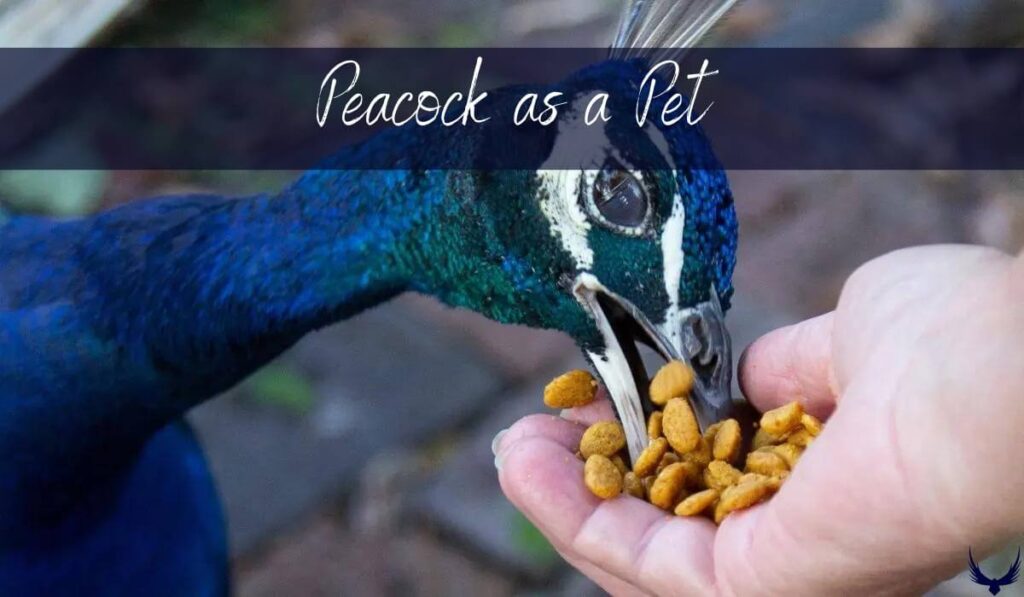
It’s best to mix these foods with fruits, vegetables, and grains for a balanced diet.
What Do Peacocks Eat in the Winter?
Peacocks eat the same food all year because they stay in one place and feel safe. Eating healthy food with lots of protein keeps them strong. Peafowl are tougher than people think, but they need to stay warm and eat well in cold winters.
Do Peacocks Eat Snakes?
Yes, peacocks eat snakes. Peacocks are cautious animals that spend a lot of time searching for food on the ground. They are alert to predators in their territory, such as snakes. Peacocks have strong beaks and sharp talons that make them skilled at catching and eating snakes.
They grab the snakes by their neck and shake them until they die. Peacocks are protective of their territory and nests and don’t want small reptiles around. In places like India and Sri Lanka, peacocks are used to control King Cobra populations.
Peacocks can deliver strong pecks and use their powerful talons for various tasks, including hunting and eating snakes.
Can Peacocks Eat Chicken Feed?
Yes, peacocks can eat chicken feed. Chicken feed is a suitable food source for peacocks as they are omnivorous and share similarities in their dietary requirements. Chicken feed is a good source of protein and other nutrients that peacocks need.
Peacocks can be fed a combination of grains, seeds, insects, and small reptiles or amphibians that are commonly found in chicken feed. This provides them with the necessary nutrients, protein, and variety they need to maintain their health and vibrant plumage. However, peacocks should not be fed only chicken feed as they have different dietary requirements.
It’s important to ensure that the chicken feed provided to peacocks is fresh and of good quality. Avoid feeding them moldy or spoiled feed, as it can be harmful to their health.
Can Peacocks Eat Bread?
Bread is not harmful to birds, but it is not very nutritious for them either. If birds eat too much bread, they can get sick. Peacocks need a diet that is high in protein and nutrients.
You can also read facts about White Peacocks.
Can peacocks Eat Cat or Dog Food?
Peafowl can eat cat or dog food sometimes, but it shouldn’t be their main food. Pet foods with lots of fats and proteins can make peafowl sick with obesity and liver issues.
Do Peacocks Eat Meat?
Peacocks are omnivorous. They eat meat as part of their diet. Their main meat sources are insects, but they also eat small lizards, rodents, and frogs.
FAQs – What do Peacocks Eat and Drink?
What Does a Peacock Eat in the Wild?
Peacocks in the wild eat various foods like small animals, reptiles, and insects. They also eat seeds and grass.
What Do Peacocks Eat in Captivity?
In captivity, peafowl are fed poultry food by their caretakers. It’s important to give them a diet high in protein for good health.
What Grains Do Peacocks Eat?
Peacocks can eat corn, wheat, beans, peas, and other grains. Cantaloupe and watermelon have large seeds with nutrients that peacocks need in their diet.
Do Peacocks Eat Ticks?
Peacocks are omnivorous so they eat both insects including ticks and mites and plants. They reduce the risk of Lyme disease by eating ticks.
Do Peacocks Eat Rats?
Yes, peacocks can eat rats if they catch them. Peacocks are not picky eaters and will eat almost anything, including rodents.

